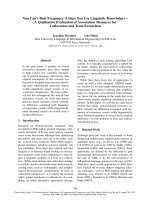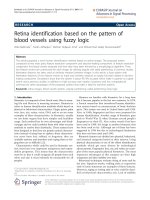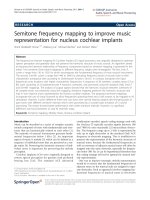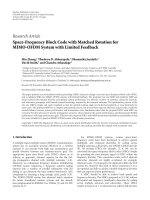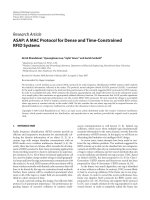Define Radio Frequency Identification (RFID)
Bạn đang xem bản rút gọn của tài liệu. Xem và tải ngay bản đầy đủ của tài liệu tại đây (680.55 KB, 54 trang )
Wireless Communications
Wireless Data Transmission
2
Objectives
•
Explain how network data is represented using binary
notation
•
List and explain the two types of wireless transmission
•
Illustrate the basic concepts and techniques through
which data can be transmitted by radio waves
3
How Data is Represented
•
Digital data for wireless communications
–
Represented using the two binary digits 0 and 1
4
The Decimal Number System
•
Decimal or Base 10 number system
–
There are 10 different symbols
•
Used to represent each digit
–
No additional symbols (beyond 0-9) are needed to
represent any number in decimal
–
Example:
5
The Binary Number System
•
Binary or Base 2 number system
–
Computers and data transmission equipment are better
suited for a base of 2
–
Binary uses a base number of 2 instead of 10
•
Two symbols are used to represent a digit, 0 and 1
•
The digits 0 and 1 are known as bits (BInary digiTS)
–
Eight binary digits grouped together form a byte
•
American Standard Code for Information Interchange
(or ASCII code)
–
Represents letters or symbols in a Base 2 system
6
The Binary Number System (continued)
•
Decimal digits represented in binary:
7
Wireless Signals
•
Wireless data signals travel on electromagnetic
waves
–
Through space at the speed of light
•
186,000 miles per second (300,000 kilometers per
second)
•
Two basic types of waves
–
Infrared light
–
Radio waves
8
Wireless Signals (continued)
9
Infrared Light
•
It is easy to transmit information with light
–
Because computers and data communication
equipment use binary code
–
A 1 in binary code could result in a light quickly flashing
on
•
Light spectrum
–
Types of light that travel from the Sun to the Earth
•
Infrared light
–
Adjacent to visible light (although invisible)
–
A much better medium for data transmission
–
Less susceptible to interference
10
Infrared Light (continued)
11
Infrared Light (continued)
•
Infrared wireless systems require:
–
Emitter that transmits a signal (LED)
–
Detector that receives the signal
•
Infrared wireless systems send data by the intensity
of the light wave
–
Detector senses the higher intensity pulse of light
•
And produces a proportional electrical current
•
Infrared wireless transmission types
–
Directed transmission (called line-of-sight or LOS)
–
Diffused transmission
12
Infrared Light (continued)
13
Infrared Light (continued)
14
Infrared Light (continued)
15
Infrared Light (continued)
•
Advantages
–
It does not interfere with other types of communication
signals
–
Infrared light does not penetrate walls
•
Signals are kept inside a room
•
Limitations
–
Lack of mobility
–
Range of coverage
•
Can cover a range of only 50 feet (15 meters)
•
Diffused infrared can only be used indoors
–
Speed of transmission
16
Infrared Light (continued)
17
Radio Waves
•
Most common and effective means of wireless
communications today
•
Energy travels through space or air in electromagnetic
waves
•
Radio (radiotelephony) waves
–
When an electric current passes through a wire, it
creates a magnetic field
•
In the space around the wire
–
As this magnetic field radiates or moves out, it creates
radio waves
18
Radio Waves (continued)
•
Advantages of radio waves
–
Can travel great distances
–
Can penetrate nonmetallic objects
–
Invisible
19
Analog and Digital
•
Analog signal
–
The intensity (voltage or amplitude) varies
–
It is broadcast continuously
–
Examples:
•
Audio
•
Video
•
Voice
•
Light
20
Analog and Digital (continued)
21
Analog and Digital (continued)
•
Digital signal
–
Consists of discrete or separate pulses
–
Has numerous starts and stops throughout the signal
stream
–
Example:
•
Morse code
•
Computers operate using digital signals
–
Analog signal must be converted into a digital format
•
Before it can be stored and processed or interpreted by a
computer
22
Analog and Digital (continued)
23
Frequency
•
Frequency
–
Rate at which a radio circuit creates the waves
–
The number of times a cycle occurs within one second
•
Cycle
–
Composed of one top [positive] and one bottom
[negative] peak
•
Carrier signal
–
Sent by radio transmitters
–
Continuous wave (CW) of constant amplitude (also
called voltage) and frequency
–
An up-and-down wave called an oscillating signal or a
sine wave
24
Frequency (continued)
25
Frequency (continued)
•
A change in voltage does not create a change in
frequency
•
The term Hertz (Hz) is used to measure frequency
–
A Kilohertz (KHz) is 1,000 Hertz
–
A Megahertz (MHz) is 1,000,000 Hertz
–
A Gigahertz (GHz) is 1,000,000,000 Hertz
•
The wave measured as 710,000 Hz is referred to as
710 KHz



